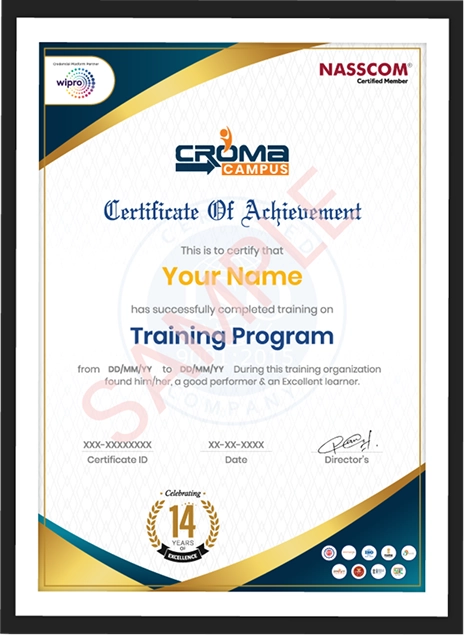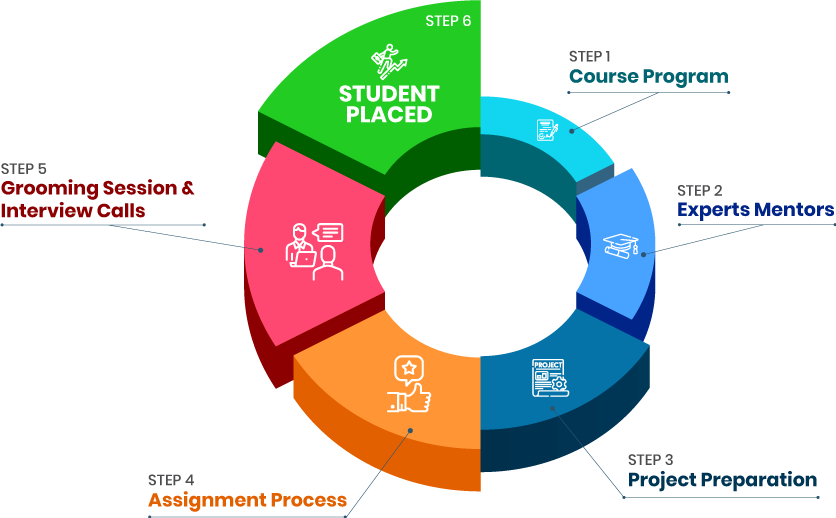- 2 Live Project
- Self-Paced/ Classroom
- Certification Pass Guaranteed
Course Offered By
Hands-on Labs: The certification offers practical labs for a real-world understanding of Azure machine learning tools and techniques.
Industry-Relevant Curriculum: Aligned with industry requirements, the course ensures participants are prepared for challenges in the field.
Expert Instructors: Learn from experienced instructors with in-depth knowledge of Azure machine learning and practical applications.
Certification Exam: Completing the course qualifies participants to take the official Azure Machine Learning Certification exam.
Data Scientists
Machine Learning Engineers
IT Professionals
Software Developers
Business Intelligence Professionals
Basic programming knowledge (preferably in Python or R)
Understanding of fundamental machine learning concepts
Familiarity with cloud computing concepts (Azure platform knowledge is a plus)
Mastering Azure Machine Learning Tools: Gain proficiency in using Azure's machine learning tools and services.
Implementing Machine Learning Models: Learn to build, train, and deploy machine learning models on the Azure platform.
Real-world Applications: Apply machine learning concepts to real-world scenarios and business problems.
Azure Services Integration: Understand how Azure machine learning integrates with other Azure services for comprehensive solutions.
Salaries may vary based on the region or country. For instance, technology hubs often offer higher compensation.
Different industries value machine learning skills differently. Sectors like finance, healthcare, and technology tend to offer lucrative packages.
Entry-level professionals may start with a competitive base salary, while those with advanced experience and expertise can command higher pay.
The complexity and responsibility of the roles undertaken influence salary levels. Senior or specialized roles generally come with higher compensation.
Holding an Azure Machine Learning Certification validates skills and can positively impact salary negotiations.
Professionals who pursue continuous learning, specialize in niche areas, or acquire additional certifications may command higher salaries.
Transition into roles focused on designing and implementing machine learning models, algorithms, and solutions.
Apply machine learning techniques to analyze and interpret complex datasets, deriving valuable insights for decision-making.
Dive into artificial intelligence development, creating solutions that emulate human-like intelligence and enhance automation.
Advance to roles involving the design and implementation of scalable, secure, and efficient cloud-based machine learning solutions.
Specialize in leveraging machine learning for business intelligence, providing actionable insights to enhance organizational strategies.
Explore specialized roles in areas such as natural language processing, computer vision, or reinforcement learning for further expertise.
Progress into leadership or management roles, overseeing machine learning teams and strategies.
Pursue entrepreneurial endeavors by applying machine learning skills to develop innovative products or services.
Industry Demand: With the increasing adoption of Azure in various industries, the demand for certified professionals is on the rise.
Comprehensive Curriculum: The certification covers a broad spectrum of machine learning topics, making participants well-rounded professionals.
Practical Applications: Emphasis on hands-on labs and real-world scenarios ensures participants can apply their knowledge effectively.
Develop and design machine learning models tailored to meet specific business requirements.
Utilize Azure Machine Learning services to create effective and efficient models.
Implement machine learning algorithms and optimize them for improved performance.
Ensure the seamless integration of machine learning solutions within Azure environments.
Analyze large datasets using Azure tools to extract meaningful insights.
Interpret data trends and patterns to facilitate informed decision-making.
Monitor machine learning models in real-time to assess their performance.
Implement improvements and optimizations to enhance model accuracy over time.
Collaborate with data engineers and scientists to streamline data pipelines.
Work in tandem to ensure the smooth flow of data for effective machine learning processes.
Implement predictive analytics using Azure Machine Learning capabilities.
Integrate predictive models into existing business processes for actionable insights.
Implement security measures to protect machine learning models and data.
Ensure compliance with data privacy regulations and industry standards.
Effectively communicate complex results and insights to non-technical stakeholders.
Use data visualization tools within the Azure environment for clear communication.
Identify and address issues related to machine learning models promptly.
Troubleshoot challenges that may arise during the deployment and execution of models.
Stay abreast of the latest advancements in Azure Machine Learning.
Continuously update skills and knowledge to leverage new features and functionalities.
Collaborate with cross-functional teams to align machine learning initiatives with overall business goals.
Participate in discussions and contribute insights to enhance data-driven decision-making.
Technology and IT: Demand for Azure machine learning professionals in tech companies for innovative solutions.
Healthcare: Utilization of Azure machine learning for improved patient outcomes and operational efficiency.
Finance: Application of Azure machine learning in financial institutions for risk management and fraud detection.
E-commerce: Leveraging Azure machine learning to enhance customer experience and optimize business operations.
Manufacturing: Implementation of Azure machine learning for efficiency and quality improvement in manufacturing.
we train you to get hired.
we train you to get hired.
By registering here, I agree to Croma Campus Terms & Conditions and Privacy Policy
Python Training Curriculum
Data Analysis and Visualization using NumPy, Pandas, and MatPlotLib,Seaborn
Introduction To Python
Python Keyword and Identifiers
Introduction To Variables:
Python Data Type:
Control Structure & Flow
Python Function, Modules and Packages
Python Date Time and Calendar:
List
Tuple
Dictionary
Sets
Strings
Python Exception Handling
Python File Handling
Python Database Interaction
Contacting user Through Emails Using Python
Reading an excel
Complete Understanding of OS Module of Python
NumPy
Pandas
MatPlotLib
Introduction to Seaborn
Python Object Oriented Programming—Oops Concepts
Arithmetic
Relational
Logical
Assignment
Membership
Identity
Django Web Framework
Getting Started with Django
Create an Application
Django - URL Mapping
Django Template Language (DTL)
Django – Models
Django – Sending E-mails
Django – Form Processing/le handling/cooking handling
Django Admin
Django API (Application Program Interface)
Static les
Placement Guide
What is a Framework
Introduction to Django
Django – Design Philosophies
History of Django
Why Django and Features
Environment setup
Web Server
MVC Pattern
MVC Architecture vs MVT Architecture
Django MVC – MVT Pattern
Creating the rst Project
Integrating the Project to sublime text
The Project Structure
Running the server
Solving the issues and Migrations
Database Setup
Setting Up Your Project.
What Django Follows
Structure of Django framework
Model Layer
What are models
Model elds
Query sets
Django – Admin Interface
Starting the Admin Interface
Migrations
Views Layer
Simple View
Basic view (displaying hello world)
Functional views, class based views
Organizing Your URLs
Role of URLs in Django
Working URLs
Forms
Sending Parameters to Views
Templates layer
The Render Function
Python Training
Data Analysis and Visualization using Pandas.
Data Analysis and Visualization using NumPy and MatPlotLib
Introduction to Data Visualization with Seaborn
Installation and Working with Python
Understanding Python variables
Python basic Operators
Understanding the Python blocks.
Python Keyword and Identiers
Python Comments, Multiline Comments.
Python Indentation
Understating the concepts of Operators
Variables, expression condition and function
Global and Local Variables in Python
Packing and Unpacking Arguments
Type Casting in Python
Byte objects vs. string in Python
Variable Scope
Declaring and using Numeric data types
Using string data type and string operations
Understanding Non-numeric data types
Understanding the concept of Casting and Boolean.
Strings
List
Tuples
Dictionary
Sets
Statements – if, else, elif
How to use nested IF and Else in Python
Loops
Loops and Control Statements.
Jumping Statements – Break, Continue, pass
Looping techniques in Python
How to use Range function in Loop
Programs for printing Patterns in Python
How to use if and else with Loop
Use of Switch Function in Loop
Elegant way of Python Iteration
Generator in Python
How to use nested Loop in Python
Use If and Else in for and While Loop
Examples of Looping with Break and Continue Statement
How to use IN or NOT IN keyword in Python Loop.
Python Syntax
Function Call
Return Statement
Arguments in a function – Required, Default, Positional, Variable-length
Write an Empty Function in Python –pass statement.
Lamda/ Anonymous Function
*args and **kwargs
Help function in Python
Scope and Life Time of Variable in Python Function
Nested Loop in Python Function
Recursive Function and Its Advantage and Disadvantage
Organizing python codes using functions
Organizing python projects into modules
Importing own module as well as external modules
Understanding Packages
Random functions in python
Programming using functions, modules & external packages
Map, Filter and Reduce function with Lambda Function
More example of Python Function
Day, Month, Year, Today, Weekday
IsoWeek day
Date Time
Time, Hour, Minute, Sec, Microsec
Time Delta and UTC
StrfTime, Now
Time stamp and Date Format
Month Calendar
Itermonthdates
Lots of Example on Python Calendar
Create 12-month Calendar
Strftime
Strptime
Format Code list of Data, Time and Cal
Locale’s appropriate date and time
What is List.
List Creation
List Length
List Append
List Insert
List Remove
List Append & Extend using “+” and Keyword
List Delete
List related Keyword in Python
List Revers
List Sorting
List having Multiple Reference
String Split to create a List
List Indexing
List Slicing
List count and Looping
List Comprehension and Nested Comprehension
What is Tuple
Tuple Creation
Accessing Elements in Tuple
Changing a Tuple
Tuple Deletion
Tuple Count
Tuple Index
Tuple Membership
TupleBuilt in Function (Length, Sort)
Dict Creation
Dict Access (Accessing Dict Values)
Dict Get Method
Dict Add or Modify Elements
Dict Copy
Dict From Keys.
Dict Items
Dict Keys (Updating, Removing and Iterating)
Dict Values
Dict Comprehension
Default Dictionaries
Ordered Dictionaries
Looping Dictionaries
Dict useful methods (Pop, Pop Item, Str , Update etc.)
What is Set
Set Creation
Add element to a Set
Remove elements from a Set
PythonSet Operations
Frozen Sets
What is Set
Set Creation
Add element to a Set
Remove elements from a Set
PythonSet Operations
Python Errors and Built-in-Exceptions
Exception handing Try, Except and Finally
Catching Exceptions in Python
Catching Specic Exception in Python
Raising Exception
Try and Finally
Opening a File
Python File Modes
Closing File
Writing to a File
Reading from a File
Renaming and Deleting Files in Python
Python Directory and File Management
List Directories and Files
Making New Directory
Changing Directory
SQL Database connection using
Creating and searching tables
Reading and Storing cong information on database
Programming using database connections
Installing SMTP Python Module
Sending Email
Reading from le and sending emails to all users
Working With Excel
Reading an excel le using Python
Writing to an excel sheet using Python
Python| Reading an excel le
Python | Writing an excel le
Adjusting Rows and Column using Python
ArithmeticOperation in Excel le.
Play with Workbook, Sheets and Cells in Excel using Python
Creating and Removing Sheets
Formatting the Excel File Data
More example of Python Function
Check Dirs. (exist or not)
How to split path and extension
How to get user prole detail
Get the path of Desktop, Documents, Downloads etc.
Handle the File System Organization using OS
How to get any les and folder’s details using OS
Categorical Data
Numerical Data
Mean
Median
Mode
Outliers
Range
Interquartile range
Correlation
Standard Deviation
Variance
Box plot
Read data from Excel File using Pandas More Plotting, Date Time Indexing and writing to les
How to get record specic records Using Pandas Adding & Resetting Columns, Mapping with function
Using the Excel File class to read multiple sheets More Mapping, Filling
Nonvalue’s
Exploring the Data Plotting, Correlations, and Histograms
Getting statistical information about the data Analysis Concepts, Handle the None Values
Reading les with no header and skipping records Cumulative Sums and Value Counts, Ranking etc
Reading a subset of columns Data Maintenance, Adding/Removing Cols and Rows
Applying formulas on the columns Basic Grouping, Concepts of Aggre
gate Function
Complete Understanding of Pivot Table Data Slicing using iLoc and Loc property (Setting Indices)
Under sting the Properties of Pivot Table in Pandas Advanced Reading
CSVs/HTML, Binning, Categorical Data
Exporting the results to Excel Joins:
Python | Pandas Data Frame Inner Join
Under sting the properties of Data Frame Left Join (Left Outer Join)
Indexing and Selecting Data with Pandas Right Join (Right Outer Join)
Pandas | Merging, Joining and Concatenating Full Join (Full Outer Join)
Pandas | Find Missing Data and Fill and Drop NA Appending DataFrame and Data
Pandas | How to Group Data How to apply Lambda / Function on Data
Frame
Other Very Useful concepts of Pandas in Python Data Time Property in Pandas (More and More)
Introduction to NumPy: Numerical Python
Importing NumPy and Its Properties
NumPy Arrays
Creating an Array from a CSV
Operations an Array from a CSV
Operations with NumPy Arrays
Two-Dimensional Array
Selecting Elements from 1-D Array
Selecting Elements from 2-D Array
Logical Operation with Arrays
Indexing NumPy elements using conditionals
NumPy’s Mean and Axis
NumPy’s Mode, Median and Sum Function
NumPy’s Sort Function and More
Bar Chart using Python MatPlotLib
Column Chart using Python MatPlotLib
Pie Chart using Python MatPlotLib
Area Chart using Python MatPlotLib
Scatter Plot Chart using Python MatPlotLib
Play with Charts Properties Using MatPlotLib
Export the Chart as Image
Understanding plt. subplots () notation
Legend Alignment of Chart using MatPlotLib
Create Charts as Image
Other Useful Properties of Charts.
Complete Understanding of Histograms
Plotting Different Charts, Labels, and Labels Alignment etc.
Introduction to Seaborn
Making a scatter plot with lists
Making a count plot with a list
Using Pandas with seaborn
Tidy vs Untidy data
Making a count plot with a Dataframe
Adding a third variable with hue
Hue and scattera plots
Hue and count plots
Introduction to relational plots and subplots
Creating subplots with col and row
Customizing scatters plots
Changing the size of scatter plot points
Changing the style of scatter plot points
Introduction to line plots
Interpreting line plots
Visualizing standard deviation with line plots
Plotting subgroups in line plots
Current plots and bar plots
Count plots
Bar plot with percentages
Customizing bar plots
Box plots
Create and interpret a box plot
Omitting outliers
Adjusting the whisk
Point plots
Customizing points plots
Point plot with subgroups
Changing plot style and colour
Changing style and palette
Changing the scale
Using a custom palette
Adding titles and labels: Part 1
Face Grids vs. Axes Subplots
Adding a title to a face Grid object
Adding title and labels: Part 2
Adding a title and axis labels
Rotating x-tics labels
Putting it all together
Box plot with subgroups
Bar plot with subgroups and subplots
Well done! What’s next
Python Training Curriculum
Data Analysis and Visualization using Pandas.
Data Analysis and Visualization using NumPy and MatPlotLib
Introduction to Data Visualization with Seaborn
Machine Learning
Installation and Working with Python
Understanding Python variables
Python basic Operators
Understanding the Python blocks.
Python Keyword and Identiers
Python Comments, Multiline Comments.
Python Indentation
Understating the concepts of Operators
Variables, expression condition and function
Global and Local Variables in Python
Packing and Unpacking Arguments
Type Casting in Python
Byte objects vs. string in Python
Variable Scope
Declaring and using Numeric data types
Using string data type and string operations
Understanding Non-numeric data types
Understanding the concept of Casting and Boolean.
Statements – if, else, elif
How to use nested IF and Else in Python
Loops
Loops and Control Statements.
Jumping Statements – Break, Continue, pass
Looping techniques in Python
How to use Range function in Loop
Programs for printing Patterns in Python
How to use if and else with Loop
Use of Switch Function in Loop
Elegant way of Python Iteration
Generator in Python
How to use nested Loop in Python
Use If and Else in for and While Loop
Examples of Looping with Break and Continue Statement
How to use IN or NOT IN keyword in Python Loop.
Python Syntax
Function Call
Return Statement
Arguments in a function – Required, Default, Positional, Variable-length
Write an Empty Function in Python –pass statement.
Lamda/ Anonymous Function
*args and **kwargs
Help function in Python
Scope and Life Time of Variable in Python Function
Nested Loop in Python Function
Recursive Function and Its Advantage and Disadvantage
Organizing python codes using functions
Organizing python projects into modules
Importing own module as well as external modules
Understanding Packages
Random functions in python
Programming using functions, modules & external packages
Map, Filter and Reduce function with Lambda Function
More example of Python Function
Day, Month, Year, Today, Weekday
IsoWeek day
Date Time
Time, Hour, Minute, Sec, Microsec
Time Delta and UTC
StrfTime, Now
Time stamp and Date Format
Month Calendar
Itermonthdates
Lots of Example on Python Calendar
Create 12-month Calendar
Strftime
Strptime
Format Code list of Data, Time and Cal
Locale’s appropriate date and time
What is List.
List Creation
List Length
List Append
List Insert
List Remove
List Append & Extend using “+” and Keyword
List Delete
List related Keyword in Python
List Revers
List Sorting
List having Multiple Reference
String Split to create a List
List Indexing
List Slicing
List count and Looping
List Comprehension and Nested Comprehension
What is Tuple
Tuple Creation
Accessing Elements in Tuple
Changing a Tuple
Tuple Deletion
Tuple Count
Tuple Index
Tuple Membership
TupleBuilt in Function (Length, Sort)
Dict Creation
Dict Access (Accessing Dict Values)
Dict Get Method
Dict Add or Modify Elements
Dict Copy
Dict From Keys.
Dict Items
Dict Keys (Updating, Removing and Iterating)
Dict Values
Dict Comprehension
Default Dictionaries
Ordered Dictionaries
Looping Dictionaries
Dict useful methods (Pop, Pop Item, Str , Update etc.)
What is Set
Set Creation
Add element to a Set
Remove elements from a Set
PythonSet Operations
Frozen Sets
What is Set
Set Creation
Add element to a Set
Remove elements from a Set
PythonSet Operations
Python Errors and Built-in-Exceptions
Exception handing Try, Except and Finally
Catching Exceptions in Python
Catching Specic Exception in Python
Raising Exception
Try and Finally
Opening a File
Python File Modes
Closing File
Writing to a File
Reading from a File
Renaming and Deleting Files in Python
Python Directory and File Management
List Directories and Files
Making New Directory
Changing Directory
SQL Database connection using
Creating and searching tables
Reading and Storing cong information on database
Programming using database connections
Installing SMTP Python Module
Sending Email
Reading from le and sending emails to all users
Working With Excel
Reading an excel le using Python
Writing to an excel sheet using Python
Python| Reading an excel le
Python | Writing an excel le
Adjusting Rows and Column using Python
ArithmeticOperation in Excel le.
Play with Workbook, Sheets and Cells in Excel using Python
Creating and Removing Sheets
Formatting the Excel File Data
More example of Python Function
Check Dirs. (exist or not)
How to split path and extension
How to get user prole detail
Get the path of Desktop, Documents, Downloads etc.
Handle the File System Organization using OS
How to get any les and folder’s details using OS
Categorical Data
Numerical Data
Mean
Median
Mode
Outliers
Range
Interquartile range
Correlation
Standard Deviation
Variance
Box plot
Read data from Excel File using Pandas More Plotting, Date Time Indexing and writing to les
How to get record specic records Using Pandas Adding & Resetting Columns, Mapping with function
Using the Excel File class to read multiple sheets More Mapping, Filling
Nonvalue’s
Exploring the Data Plotting, Correlations, and Histograms
Getting statistical information about the data Analysis Concepts, Handle the None Values
Reading les with no header and skipping records Cumulative Sums and Value Counts, Ranking etc
Reading a subset of columns Data Maintenance, Adding/Removing Cols and Rows
Applying formulas on the columns Basic Grouping, Concepts of Aggre
gate Function
Complete Understanding of Pivot Table Data Slicing using iLoc and Loc property (Setting Indices)
Under sting the Properties of Pivot Table in Pandas Advanced Reading
CSVs/HTML, Binning, Categorical Data
Exporting the results to Excel Joins:
Python | Pandas Data Frame Inner Join
Under sting the properties of Data Frame Left Join (Left Outer Join)
Indexing and Selecting Data with Pandas Right Join (Right Outer Join)
Pandas | Merging, Joining and Concatenating Full Join (Full Outer Join)
Pandas | Find Missing Data and Fill and Drop NA Appending DataFrame and Data
Pandas | How to Group Data How to apply Lambda / Function on Data
Frame
Other Very Useful concepts of Pandas in Python Data Time Property in Pandas (More and More)
Introduction to NumPy: Numerical Python
Importing NumPy and Its Properties
NumPy Arrays
Creating an Array from a CSV
Operations an Array from a CSV
Operations with NumPy Arrays
Two-Dimensional Array
Selecting Elements from 1-D Array
Selecting Elements from 2-D Array
Logical Operation with Arrays
Indexing NumPy elements using conditionals
NumPy’s Mean and Axis
NumPy’s Mode, Median and Sum Function
NumPy’s Sort Function and More
Bar Chart using Python MatPlotLib
Column Chart using Python MatPlotLib
Pie Chart using Python MatPlotLib
Area Chart using Python MatPlotLib
Scatter Plot Chart using Python MatPlotLib
Play with Charts Properties Using MatPlotLib
Export the Chart as Image
Understanding plt. subplots () notation
Legend Alignment of Chart using MatPlotLib
Create Charts as Image
Other Useful Properties of Charts.
Complete Understanding of Histograms
Plotting Different Charts, Labels, and Labels Alignment etc.
Introduction to Seaborn
Making a scatter plot with lists
Making a count plot with a list
Using Pandas with seaborn
Tidy vs Untidy data
Making a count plot with a Dataframe
Adding a third variable with hue
Hue and scattera plots
Hue and count plots
Introduction to relational plots and subplots
Creating subplots with col and row
Customizing scatters plots
Changing the size of scatter plot points
Changing the style of scatter plot points
Introduction to line plots
Interpreting line plots
Visualizing standard deviation with line plots
Plotting subgroups in line plots
Current plots and bar plots
Count plots
Bar plot with percentages
Customizing bar plots
Box plots
Create and interpret a box plot
Omitting outliers
Adjusting the whisk
Point plots
Customizing points plots
Point plot with subgroups
Changing plot style and colour
Changing style and palette
Changing the scale
Using a custom palette
Adding titles and labels: Part 1
Face Grids vs. Axes Subplots
Adding a title to a face Grid object
Adding title and labels: Part 2
Adding a title and axis labels
Rotating x-tics labels
Putting it all together
Box plot with subgroups
Bar plot with subgroups and subplots
Well done! What’s next
Introduction To Python
Python Keyword and Identiers
Introduction To Variables
Python Data Type
Control Structure & Flow
Python Function, Modules and Packages
List
Tuple
Dictionary
Sets
Strings
Python Exception Handling
Python File Handling
Python Database Interaction
Reading an excel
Complete Understanding of OS Module of Python
Data Analysis and Visualization using Pandas.
Data Analysis and Visualization using NumPy
Data Analysis and Visualization using MatPlotLib
Introduction to Data Visualization with Seaborn
Foundation for AI: Learn traditional ML models, evaluation, and workflows.
Understand the inner workings of neural networks and train them with Keras.
Master CNNs, object detection, segmentation, and deployment.
Introduction to ML, AI, and Deep Learning
Types of ML (Supervised, Unsupervised, Reinforcement)
ML Pipeline: Data Cleaning, Feature Engineering
Common ML Algorithms: Linear, Logistic, DT, RF, SVM, KNN
Model Evaluation: Accuracy, Precision, Recall, F1, ROC-AUC
Overfitting, Underfitting, Cross-Validation
Hands-on Project: Titanic Dataset (or similar)
Introduction to Neural Networks & Deep Learning
Activation Functions (ReLU, Sigmoid, Tanh)
Feedforward Neural Network
Backpropagation & Gradient Descent
Learning Rate, Schedulers & Optimizers (SGD, Adam, RMSProp)
Softmax, Cross-Entropy Loss
Keras Basics: Sequential API & Functional API
Fully Connected Layer – Forward/Backward Pass
Regularization – Dropout, Batch Normalization
Data Preprocessing & Data Augmentation
Weight Initialization Strategies
Babysitting Learning: Overfit detection, TensorBoard Monitoring
Hands-on: MLP on MNIST / Tabular data (e.g. HR Analytics)
Basics of Images, Image Preprocessing
Convolution: 2D Conv, Forward & Backward
Pooling, Padding, Stride, Transposed Conv
CNN Architectures: LeNet, AlexNet, VGG, ResNet
GPU vs CPU for DL
Transfer Learning: Inception, MobileNet, fine-tuning
Semantic Segmentation using UNet
Object Detection – YOLO, SSD, Region Proposal
Bounding Box Regressor
Siamese Networks for Similarity Search
Hands-on:
Introduction to NLP and Use Cases
Preprocessing: Tokenization, Lemmatization, Stopwords, Normalization
Feature Extraction: BOW, TF-IDF, N-Grams
Word Embeddings: Word2Vec, GloVe, Dense Vectors
POS Tagging, Named Entity Recognition
RNN, LSTM – Forward Pass and BPTT
Advanced LSTM Applications + Architectures
Attention Mechanism + Encoder-Decoder
Transformers, BERT, Hugging Face Pipelines
NLP Evaluation Metrics: BLEU, ROUGE
Hands-on:
Saving & Loading Models (Pickle, Joblib, Keras)
Flask vs FastAPI – Serving ML models
Streamlit/Gradio for Web Apps
Hosting Models on Hugging Face Spaces, Streamlit Cloud
MLflow Intro – Model Tracking & Versioning
Hands-on:
Internet of Things (IoT) Introduction
IoT Architecture
Understanding IoT Ecosystems
Raspberry Pi
IoT Gateways
Cloud Platforms for IoT
IoT Implementations [Applications]
Future & Security Concerns
Background and Development
Three waves of Internet
Why IoT
Market Analysis & Investment In IoT
Industrial & Consumer IoT
M2M communication and automation history
Relation with embedded systems
General introduction to Arduino , Raspberry Pi and SmartWifi boards
How IoT Works
High level Data Flow in IoT
Technical Architecture
Description of all layers of IoT Architecture
Technologies for IoT
What is IoT application
What are basic elements / building blocks of IoT app
How are these blocks connected together
The systematic method to design IoT application
Architecting our hands-on project
Learning fundamentals of Raspberry Pi
Different types of pi boards.
Installation of OS in Raspberry Pi
Programming Raspberry Pi Using Python
Installation and Working with Python
Understanding Python variables
Python basic Operators
Understanding the Python blocks.
Python Comments, Multiline Comments.
Python Indentation
Understating the concepts of Operators
Categorical Data
Numerical Data
Mean
Median
Mode
Outliers
Range
Interquartile range
Correlation
Standard Deviation
Variance
Box plot
Descriptive Statistics
Sample vs Population Statistics
Random variables
Probability distribution functions
Expected value
Normal distribution
Gaussian distribution
Z-score
Spread and Dispersion
Correlation and Co-variance
Data Preparation
Feature Engineering
Feature Scaling
Datasets
Dimensionality Reduction
Anomaly Detection
Parameter Estimation
Data and Knowledge
Selected Applications in Data Mining
Need for structured exploratory data
EDA framework for exploring the data and identifying any problems with the data (Data Audit Report)
Identify missing data
Identify outliers’ data
Imbalanced Data Techniques
Read data from Excel File using Pandas More Plotting, Date Time Indexing and writing to les
How to get record specic records Using Pandas Adding & Resetting Columns, Mapping with function
Using the Excel File class to read multiple sheets More Mapping, Filling Nonvalue’s
Exploring the Data Plotting, Correlations, and Histograms
Getting statistical information about the data Analysis Concepts, Handle the None Values
Reading les with no header and skipping records Cumulative Sums and Value Counts, Ranking etc
Reading a subset of columns Data Maintenance, Adding/Removing Cols and Rows
Applying formulas on the columns Basic Grouping, Concepts of Aggre gate Function
Complete Understanding of Pivot Table Data Slicing using iLoc and Loc property (Setting Indices)
Under sting the Properties of Pivot Table in Pandas Advanced Reading CSVs/HTML, Binning, Categorical Data
Exporting the results to Excel Joins
Python | Pandas Data Frame Inner Join
Under sting the properties of Data Frame Left Join (Left Outer Join)
Indexing and Selecting Data with Pandas Right Join (Right Outer Join)
Pandas | Merging, Joining and Concatenating Full Join (Full Outer Join)
Pandas | Find Missing Data and Fill and Drop NA Appending Data Frame and Data
Pandas | How to Group Data How to apply Lambda / Function on Data Frame
Other Very Useful concepts of Pandas in Python Data Time Property in Pandas (More and More)
Introduction to NumPy Numerical Python
Importing NumPy and Its Properties
NumPy Arrays
Creating an Array from a CSV
Operations an Array from a CSV
Operations with NumPy Arrays
Two-Dimensional Array
Selecting Elements from 1-D Array
Selecting Elements from 2-D Array
Logical Operation with Arrays
Indexing NumPy elements using conditionals
NumPy’s Mean and Axis
NumPy’s Mode, Median and Sum Function
NumPy’s Sort Function and More
Bar Chart using Python MatPlotLib
Column Chart using Python MatPlotLib
Pie Chart using Python MatPlotLib
Area Chart using Python MatPlotLib
Scatter Plot Chart using Python MatPlotLib
Play with Charts Properties Using MatPlotLib
Export the Chart as Image
Understanding plt. subplots () notation
Legend Alignment of Chart using MatPlotLib
Create Charts as Image
Other Useful Properties of Charts.
Complete Understanding of Histograms
Plotting Different Charts, Labels, and Labels Alignment etc.
Introduction to Seaborn
Making a scatter plot with lists
Making a count plot with a list
Using Pandas with seaborn
Tidy vs Untidy data
Making a count plot with a Dataframe
Adding a third variable with hue
Hue and scattera plots
Hue and count plots
Visualizing Two Quantitative Variables
Visualizing a Categorical and a Quantitative Variable
Customizing Seaborn Plots
we train you to get hired.
Phone (For Voice Call):
+91-971 152 6942WhatsApp (For Call & Chat):
+919711526942Stories
success
inspiration
career upgrade
career upgrade
career upgrade
career upgrade
You will get certificate after
completion of program
You will get certificate after
completion of program
You will get certificate after
completion of program
in Collaboration with

Empowering Learning Through Real Experiences and Innovation
we train you to get hired.
Phone (For Voice Call):
+91-971 152 6942WhatsApp (For Call & Chat):
+919711526942Get a peek through the entire curriculum designed that ensures Placement Guidance
Course Design By
Course Offered By
Ready to streamline Your Process? Submit Your batch request today!
The course duration may vary but typically spans a few months, depending on the curriculum.
Basic programming knowledge and understanding of machine learning concepts are recommended, but prior experience is not mandatory.
Career support may include resume assistance, interview preparation, and job placement guidance.
Yes, Croma Campus is a reliable choice to help you become a certified Azure machine learning professional.
Highest Salary Offered
Average Salary Hike
Placed in MNC’s
Year’s in Training

fast-tracked into managerial careers.
Get inspired by their progress in the
Career Growth Report.
FOR QUERIES, FEEDBACK OR ASSISTANCE
Best of support with us
For Voice Call
+91-971 152 6942For Whatsapp Call & Chat
+91-9711526942





















